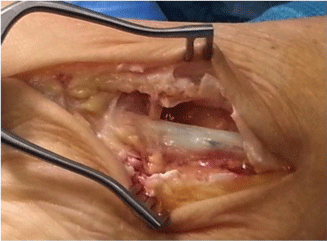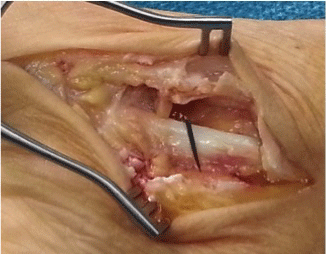We report an unusual case of tibialis posterior tendinitis in an active man with a history of puncture wound in the sole. Although no definite cause of the problem was initially identified, surgical exploration of the tendon revealed a foreign body in the tendon sheath. This case emphasizes the principle of treating the patient's symptoms and signs rather than relying solely on investigations. Similar diagnosis should be kept in mind in anyone considered for patients with a history of inexplicable tendinitis around the ankle with a history of penetrating injury in the sole.
Tibialis posterior, Tendinitis, Foreign body
Tibilais tendinitis with associated degeneration of the tendon is not unusual in middle-aged individuals. One of the rare and unusual causes of Tibialis tendinitis is a foreign body induced inflammation of the tendon. The aim of this case report is to present an unusual case of tibialis posterior tendinitis in an active man with a history of puncture wound in the sole. Although no definite cause of the problem was initially identified, surgical exploration of the tendon revealed a foreign body in the tendon sheath. Patient underwent full recovery following removal of this foreign body indicating this to be the cause of his symptoms.
A 71-years-old gentleman was referred to the foot & ankle specialists with a 6 weeks history of pain and swelling in his right foot following a prick with a spine of a sea urchin whilst in a vacation at the Caribbean's. Patient underwent an ultrasound locally and was reported to have a foreign body in the foot. He was initially treated with a course of oral antibiotics for a week without much benefit. On examination he was found to have a healed puncture wound on the medial aspect of his right sole.
There was erythema and palpable tenderness over the tibialis posterior tendon along with a cystic swelling. The range of movement in the right ankle and subtalar joints were full and relatively pain free. Patient was still able to stand tiptoe with a flexible hind foot albeit with pain. A radiograph was obtained which failed to show any foreign body and hence a Magnetic Resonance Scan (MRI) scan was ordered. The scan revealed evidence of oedema and synovitis of the distal tibialis posterior tendon. However no evidence of a foreign body was revealed. Furthermore, there was no evidence of inflammation or scarring in the subcutaneous tissue and underlying planter fascia at the site of initial puncture in the sole. As no definite cause of tenditis was delineated, surgical exploration of the tendon was decided.
An incision was made directly over the swelling of the tibialis posterior tendon. Tendon sheath and flexor retinaculum was exposed. Few milliliters of straw-colored fluid was encountered and sent for microbiological culture. A sea urchin spine was found lodged into the tendon (Figure 1). There was a small tear in the tendon with synovitis and degenerative changes around. The rest of the hind foot and surrounding soft tissues were inspected but no pathology was found. Extensive debridement of the tendon was undertaken after removal of the spine. The tendon was repaired with 2/0 absorbable sutures (Figure 2). The flexor retinaculum was then repaired followed by closure of tendon sheath after a thorough saline irrigation. Patient was immobilized in a plaster slab for 2 weeks followed by gradual rehabilitation to restore tibialis posterior tendon strength. Microbiological samples were sterile. Patient was reviewed finally at 8 weeks postsurgery, when his symptoms had resolved fully and he had started playing golf as usual.
 Figure 1: Foreign body seen embedded within tibialis posterior tendon.
View Figure 1
Figure 1: Foreign body seen embedded within tibialis posterior tendon.
View Figure 1
 Figure 2: Sea Urchin spine removed from the tibialis posterior tendon. Note the length of the foreign body compared to the tendon.
View Figure 2
Figure 2: Sea Urchin spine removed from the tibialis posterior tendon. Note the length of the foreign body compared to the tendon.
View Figure 2
The tibialis posterior muscle originates from the posterior proximal tibia, interosseous membrane and proximal fibula. It travels through the posterior compartment of the leg before travelling behind medial malleolus. There by it changes its line of pull from the vertical to the horizontal direction. It has a broad insertion into the plantar medial midfoot; with a major portion inserting into the navicular tuberosity, another into the sustentaculum tali, and the remaining portion inserting into the entire plantar midfoot except for the 5th metatarsal [1].
The commonest mechanism of tendinitis is overuse. Increased pronation at subtalar joint during physical activity leads to stress and eventually microrupture of the tendon. The resultant inflammation causes pain and dysfunction culminating to flatfoot deformity [2].
Tibialis posterior tendinitis can be associated with tendon dysfunction secondary to lengthening or rupture. This condition is usually seen in women older than 50 years [3,4]. Untreated, results in loss of tendon function due to degenerative changes in the tendon itself. As tibialis posterior acts as a dynamic support of the longitudinal arch, it can lead to progressive flatfoot deformity [5]. Tibialis posterior dysfunction can be staged (I to IV) by assessing pain, deformity, flexibility of the hind foot, ability to perform single leg heel rise, subtalar arthritis and ankle arthritis [6]. The tibialis posterior tendon undertakes an acute angulation as it passes posterior to the medial malleolus. The zone of hypovascularity distal to the medial malleolus contributes to the pathology. The hypovascular zone is the area in which most degenerative changes and ruptures are found [4,7]. Patients can develop this condition due to primary idiopathic degenerative changes or secondary to inflammatory conditions, trauma or infection [1,8]. Foreign body induced tibilais posterior tendinitis is extremely rare and rarely reported [9]. Diagnosis is based on history and clinical examination complemented with radiographs, ultrasonographs or MRI scan as necessary to exclude other causes of medial ankle pain and flatfoot deformity. An MRI was indicated in this case to assess the tibialis posterior tendon as the possibility of a foreign body was not apparent and clinical features were indicative of tendon related damage. As a general rule MRI is not indicated if a foreign body is apparent in radiographs or ultrasonographs. Investigations also aid in pinpointing the cause of the tendinitis if secondary causes are suspected [10].
Our patient presented with a complaint of foreign body in the sole of the foot. His symptoms and signs however indicated a tibialis posterior tendinitis. We suspected a secondary cause and investigated this patient extensively. None of the investigations other than ultrasonographs showed the evidence of a foreign body. Furthermore, the exact location of the sea urchin spine was revealed only after surgical exposure. The exact reason for a negative MRI scan is difficult to predict, there is a possibility that the foreign body might have been missed between the cut sections. The main indication of surgery in this case was persistence of symptoms. Although the MRI scan failed to reveal any significant pathology, a surgical exploration was deemed appropriate based on ongoing symptoms mainly to assess the integrity of tibialis posterior tendon.
We feel the shape of the sea urchin spine had implication on its migration proximally. Wedged structure of the spine allowed it to push up through the soft tissues proximally with every step and eventually end within the tibialis tendon sheath. It partially penetrated the tendon, but could not migrate further causing intense inflammatory reaction in the surrounding tissues secondary to friction and microtrauma. We must treat patient's symptoms and signs rather than relying solely on investigations. In spite of negative scans, surgical exploration was undertaken to reveal the true pathology and helped in resolution of the problem.
We are not aware of any previous report of migrating foreign body causing tibialis posterior tendinitis. Furthermore, this diagnosis should be kept in mind in anyone with a history of inexplicable tendinitis around the ankle with a history of penetrating injury in the sole.